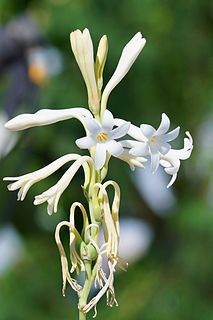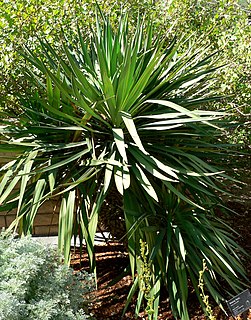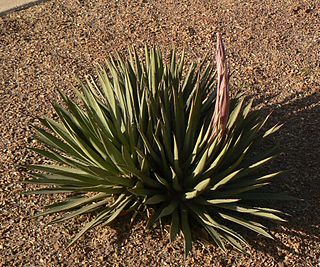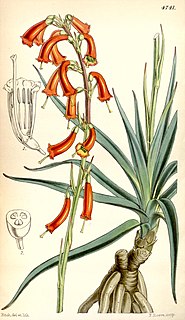
Sisal, with the botanical name Agave sisalana, is a species of flowering plant native to southern Mexico but widely cultivated and naturalized in many other countries. It yields a stiff fibre used in making rope and various other products. The term sisal may refer either to the plant's common name or the fibre, depending on the context. It is sometimes referred to as "sisal hemp", because for centuries hemp was a major source for fibre, and other fibre sources were named after it.

Mezcal is a distilled alcoholic beverage made from any type of agave. The word mezcal comes from Nahuatl mexcalli[meʃˈkalːi], which means "oven-cooked agave", from metl[met͡ɬ] and ixcalli[iʃˈkalːi].

Agavoideae is a subfamily of monocot flowering plants in the family Asparagaceae, order Asparagales. It has previously been treated as a separate family, Agavaceae. The group includes many well-known desert and dry-zone types, such as the agaves and yuccas. About 640 species are placed in around 23 genera; they are widespread in the tropical, subtropical, and warm temperate regions of the world.

Agave americana, common names sentry plant, century plant, maguey or American aloe, is a species of flowering plant in the family Asparagaceae, native to Mexico and the United States in Texas. Today, it is cultivated worldwide as an ornamental plant. It has become naturalized in many regions, including the West Indies, parts of South America, the southern Mediterranean Basin, and parts of Africa, India, China, Thailand, and Australia.

Agave amica, formerly Polianthes tuberosa, the tuberose, is a perennial plant in the family Asparagaceae, subfamily Agavoideae, extracts of which are used as a note in perfumery. Now widely grown as an ornamental plant, the species was originally native to Mexico.

Agave tequilana, commonly called blue agave or tequila agave, is an agave plant that is an important economic product of Jalisco, Mexico, due to its role as the base ingredient of tequila, a popular distilled beverage. The high production of sugars named agavins, mostly fructose, in the core of the plant is the main characteristic that makes it suitable for the preparation of alcoholic beverages.

Agave parryi, known as Parry's agave or mescal agave, is a flowering plant in the family Asparagaceae. It is a slow-growing succulent perennial native to Arizona, New Mexico, and northern Mexico.

Agave deserti is an agave native to desert regions in southern California, Arizona, and Baja California. Its tall yellow flower stalks dot dry rocky slopes and washes throughout the spring.

Agave shawii, with the common names coastal agave or Shaw's agave, is a very rare and critically endangered species in the genus Agave native to southwestern California and Baja California. The plant is named for Henry Shaw, the founder of the Missouri Botanical Garden.

Yucca gloriosa var. tristis, known as curve-leaf yucca, curved-leaved Spanish-dagger or pendulous yucca, is a variety of Yucca gloriosa. It is often grown as an ornamental plant, and is native to the southeastern United States, from coastal North Carolina south through Florida and west to Texas. In contrast to Y. gloriosa var. tristis, the leaves of Y. gloriosa var. gloriosa are hard stiff, erect and narrower.

Agave parryi var. huachucensis, synonym Agave huachucensis, is a variety of Agave parryi subsp. parryi. It is commonly known as the Huachuca agave.

Agave salmiana is a species of the family Asparagaceae, native to central and southern Mexico. It is also reportedly naturalized in South Africa, Italy and Spain, specially in the Canary Islands.

Agave is a genus of monocots native to the hot and arid regions of the Americas, although some Agave species are also native to tropical areas of South America. The genus Agave is primarily known for its succulent and xerophytic species that typically form large rosettes of strong, fleshy leaves. Agave now includes species formerly placed in a number of other genera, such as Manfreda, ×Mangave, Polianthes and Prochnyanthes.

Echinocereus chisoensis is a rare North American species of cactus known by the common name Chisos Mountain hedgehog cactus, native to the Chihuahuan Desert of northern Mexico and the south-central United States.
Agave phillipsiana is a rare species of flowering plant in the asparagus family known by the common names Grand Canyon century plant and Phillips agave. It is endemic to Arizona in the United States, where it lives only in Grand Canyon National Park.

Agave × arizonica is a rare plant, endemic to Arizona. It is a hybrid between two species of Agave in the family Asparagaceae, A. chrysantha and A. toumeyana var. bella. It was discovered in the 1960s near a summit of the New River Mountains, near the Maricopa-Yavapai county line north of Phoenix, Arizona.
Agave schottii, also known by the common name Schott's century plant, is a shrub species within the genus Agave. It is a member of the subgenus Littaea. There are two widely recognized varieties of this species: Agave schotti var. schottii and Agave schottii var. treleasei.

Agave weberi, known as maguey liso in Spanish and as Weber agave in English, is a succulent perennial plant in the family Asparagaceae, subfamily Agavoideae. Under the synonym Agave neglecta, it is known as wild century plant and Small agave – the latter in honor of its discoverer in Florida, John Kunkel Small. Naturalized populations in Florida were considered to be a separate species, but are now treated as synonymous with A. weberi.

Agave coetocapnia is a species of flowering plant in the family Asparagaceae, native to Mexico. It was first described in 1824 as Bravoa geminiflora. It has been known by several other scientific names, including, in whole or part, Polianthes geminiflora. It has been cultivated as an ornamental plant.
















